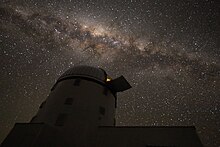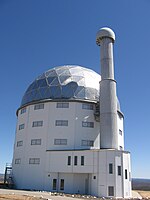South African Astronomical Observatory
Sutherland, Northern Cape | |
| Coordinates | Headquarters: 33°56′05″S 18°28′39″E / 33.9347°S 18.4776°E Sutherland: 32°22′42″S 20°48′38″E / 32.3783°S 20.8105°E |
|---|---|
| Established |
|
South African Astronomical Observatory (SAAO) is the national centre for optical and infrared astronomy in South Africa. It was established in 1972. The observatory is run by the
The SAAO has links worldwide for scientific and technological collaboration. Instrumental contributions from the South African Astronomical Observatory include the development of a spherical aberration corrector and the Southern African Large Telescope (SALT).
The Noon Gun on Cape Town's Signal Hill is fired remotely by a time signal from the Observatory.
History

The history of the SAAO began when the
). The post of His/Her Majesty's astronomer at the Cape of Good Hope was awarded theThe
SAAO was established in January 1972, as a result of a joint agreement by the Council for Scientific and Industrial Research (CSIR) of South Africa and Science and Engineering Research Council (SERC) of United Kingdom. The headquarters are located on the grounds of the old Royal Observatory where the main building, offices, national library for astronomy and computer facilities are housed. Historic telescopes are also found at the headquarters in a number of domes and a small museum that displays scientific instruments. The South African Astronomical Observatory is administered at present as a National Facility under management of the National Research Foundation (NRF), formerly the Foundation for Research Development (FRD). In 1974, when the Radcliffe Observatory in Pretoria closed, the Council for Scientific and Industrial Research (CSIR) purchased the 1.9-m Radcliffe telescope and transported it to Sutherland.[8]
Facilities
The observatory operates from the campus of the Royal Observatory, Cape of Good Hope that was established in 1820[9] in the suburb of Observatory, Cape Town.
The major observing facilities are, however, located near the town of Sutherland some 370 kilometres (230 mi)[2] from Cape Town. Sutherland was chosen because of its reliably clear and dark nights, but to ensure long term viability of the Karoo site astronomy instruments, the South African Parliament passed the Astronomy Geographic Advantage Act in 2007. The act gives the Minister of Science and Technology the authority to protect areas, through regulations, that are of strategic national importance for astronomy and related scientific endeavours.
Telescopes

0.50m telescope
This 0.5 metres (20 in) reflector was originally built for the
The 20" telescope was replaced with the Meerlicht telescope. The 20" telescope was relocated to the University of Freestate Boyden observatory and commissioned in ~2019[10]
0.75m telescope
A 0.75 metres (30 in)
1.0m Telescope

This 40 inches (1.0 m) telescope was originally located at SAAO Head office in Observatory, Cape Town, but has since moved to the Sutherland site.[11] This telescope participates in the PLANET network.[12]
1.9m Telescope

The 1.9-m (74-inch) Radcliffe Telescope was commissioned for the
Alan Cousins Telescope (ACT)
This 29.5 inches (75 cm) telescope was originally called the Automatic Photometric Telescope, but has been renamed the Alan Cousins Telescope in honour of Alan William James Cousins.[15][16]
BiSON
One of six telescopes in the Birmingham Solar Oscillations Network
Infrared Survey Facility (IRSF)
The IRSF is a 140 centimetres (55 in) reflector fitted with a 3 colour Infrared Imager.
- The Indian
Las Cumbres Observatory Global Telescope Network
Three 1 metre (39 in) telescopes to form part of the LCOGT network were installed in early 2013.[20]
MASTER
The MASTER-SAAO Telescope (obs. code:
MONET
One of the two 1.20 metres (47 in) telescopes of the MOnitoring NEtwork of Telescopes Project is located at Sutherland. Its twin can be found at the McDonald Observatory in Texas.[24] The MONET telescopes are Robotic telescope controllable via the Internet and was constructed by the University of Göttingen.[25] Remote Telescope Markup Language is used to control the telescopes remotely.[26]
PRIME

Project Solaris

Two telescopes forming part of

Southern African Large Telescope (SALT)
- Observatory Code: B31
- Observations: (Near Earth Objects)
SALT was inaugurated in November 2005. It is the largest single optical telescope in the Southern Hemisphere, with a hexagonal mirror array 11 meters across. SALT shares similarities with the

SuperWASP-South
The Wide Angle Search for Planets consists of two
KELT-South
KELT-South (Kilodegree Extremely Little Telescope – South) is a small robotic telescope that is designed to detect transiting extrasolar planets. The telescope is owned and operated by Vanderbilt University and was based on the design of KELT-North, which was conceived and designed at the Ohio State University, Department of Astronomy. The KELT-South telescope will serve as a counterpart to its northern twin, surveying the southern sky for transiting planets over the next few years.
MeerLICHT
- Observatory Code: List of observatory codes § L66
Optical wide-field telescope, installed in 2017. It has a 60 cm (24 in) effective aperture, and a 1.65 x 1.65 degree field-of-view, sampled at 0.56"/pix. It was designed and manufactured in the Netherlands (

Yonsei Survey Telescopes for Astronomical Research (YSTAR)
- Observatory Code: List of observatory codes § A60
The Yonsei Survey Telescopes for Astronomical Research (YSTAR), decommissioned in 2012, was used for the monitoring of variable stars and other transient events. YSTAR was a joint project between SAAO and the Yonsei University, Korea.[25]
Geophysical
South African Geodynamic Observatory Sutherland (SAGOS)
The GeoForschungsZentrum, Potsdam in co-operation with the
SAGOS consist of a 1 Hz permanent GPS station, a superconducting gravimeter, meteorological sensors, and a tri-axial magnetometer. The GPS station is also used in support of the
SUR Station
The SUR station forms part of the
See also
- National Research Foundation of South Africa
- Astronomical Society of Southern Africa
- SEDSSEDS South Africa
- Other optical observatories and telescopes in South Africa
- Radio observatories and telescopes in South Africa
- Magnetic observatories in South Africa
- Hermanus Magnetic Observatory
References
- ^ "SAAO Annual Review 2020-2021" (PDF).
- ^ a b "Additional information about SAAO Sutherland". South African Astronomical Observatory. Archived from the original on 14 October 2010. Retrieved 3 October 2010.
- South African Department of Science and Technology. Archived from the originalon 30 August 2009. Retrieved 30 January 2009.
- ^ "The Transit of Venus – The Expedition at the Cape of Good Hope". The New York Times. 6 December 1874. Retrieved 16 July 2011.
- ^ UK Retail Price Index inflation figures are based on data from Clark, Gregory (2017). "The Annual RPI and Average Earnings for Britain, 1209 to Present (New Series)". MeasuringWorth. Retrieved 11 June 2022.
- ^ "Royal archive winners before 1900". The Royal Society. Retrieved 6 December 2008.
- ^ "Royal Medal Winners:1949 – 1900". The Royal Society. Retrieved 1 December 2008.
- ISBN 978-1-4020-0812-2.
- ^ Holden, Edward Singleton (1888). "The Principal Observatories of the World". Hand-book of the Lick Observatory of the University of California. p. 112. Retrieved 2 October 2010.
- ^ "Astrophysics Research Facilities".
- ^ "The 40-inch Elizabeth telescope". South African Astronomical Observatory. Archived from the original on 19 September 2012. Retrieved 28 January 2009.
- ^ "It's Far, It's Small, It's Cool: It's an Icy Exoplanet! Distant Planet Brings Astronomers Closer To Home" (PDF). Retrieved 15 May 2009.
- ^ "Radcliffe 74-inch (1.9-m)". South African Astronomical Observatory. Retrieved 3 May 2017.
- ^ Astronomical Instruments. Grubb Parsons. 1956.
- ^ "The Alan Cousins Telescope – Automatic Photometric Telescope". South African Astronomical Observatory. Archived from the original on 9 September 2012. Retrieved 29 January 2009.
- ^ "Automatic Photometric Telescope (APT)". Astronomical Society of Southern Africa. Archived from the original on 18 July 2011. Retrieved 29 January 2009.
- ^ "IRSF telescope". South African Astronomical Observatory. Archived from the original on 9 September 2012. Retrieved 30 January 2009.
- ISSN 0374-2466.
- Bibcode:2003BASI...31..403B.
- S2CID 118585975.
- ^ "First Light with MASTER-SAAO". SAAO – South African Astronomical Observatory. 23 December 2014. Retrieved 3 May 2017.
- ^ MASTER-SAAO
- ^ "C/2015 G2 (MASTER) is first South African Comet discovery in 35 years". Africa2Moon. Archived from the original on 12 May 2015. Retrieved 20 May 2015.
- ^ "Research Facilities". McDonald Observatory. Retrieved 15 May 2009.
- ^ a b "Telescopes". South African Astronomical Observatory. Retrieved 30 January 2009.
- Bibcode:2003AAS...202.3809H.
- ^ "SAAO | Astronomers". Retrieved 13 June 2023.
- ^ "UMD Astronomy: 2022 News". Retrieved 13 June 2023.
- ^ "NASA's Roman Mission Delivers Detectors to Japan's PRIME Telescope". Retrieved 13 June 2023.
- ^ "PRime-focus Infrared Microlensing Experiment". Retrieved 13 June 2023.
- ISSN 0024-8266.
- ^ "First Light". South African Large Telescope. Retrieved 15 May 2009.
- ^ "Welcome to the WASP website". SuperWASP. Archived from the original on 8 December 2002. Retrieved 30 January 2009.
- ^ "South African Geodynamic Observatory Sutherland (SAGOS)". Helmholtz Centre Potsdam GFZ German Research Centre for Geosciences. Retrieved 30 January 2009.
- ^ "Geophysical Facilities". South African Astronomical Observatory. Retrieved 30 January 2009.
- ^ "Station SUR, Sutherland, Republic of South Africa". Project IDA. Retrieved 30 January 2009.
Further reading
- Wiehahn, Michelle (February 2002). Using the SAAO Automatic Photometric Telescope to Study the Long-Term Lightcurves of Cataclysmic Variables (PDF) (BSc (Hons) thesis). University of Cape Town – Department of Astronomy. Archived from the original (PDF) on 21 August 2011.
External links
| External image | |
|---|---|
- Official Website
- SALT Homepage
- SALT milestones, first-light
- SALT milestones, inauguration
- BiSON Homepage
- SuperWASP Homepage
- KELT-South Homepage
- SuperWASP-South live status
- MeerLICHT homepage
- SUR listing at Project IDA
- South Africa's Giant New Observatory. Construction of the 1.9m Radcliffe Telescope, AP Archive.
- flicker

